Ethiopia is mesmerising. To date, it remains firmly at the top of my Wanderlustlist of places I have set Footsteps in. This country, its treasures and her people have left an indelible mark on me and I only want to explore it more. This is the first part in my series titled Footsteps in Ethiopia: please do stay tuned for upcoming posts on my musings and memoirs from our adventures in the places that we explored in what is truly an epic country. For now, I hope you enjoy this snapshot into Ethiopia following the itinerary that Wanderlustmate M and I curated after lots of research on what we wanted to experience.
Ethiopia is a huge country, almost 5 times larger than the United Kingdom and unless you are a full time wanderluster with oodles of time on your hands, chances are you will have to pick and choose what parts to see. Tourism is still developing, solo or independent travel is still a new concept and a handful of luxury operators have tours for the Northern and Southern parts for which they charge a handsome price, which is fine if you have deep pockets however you will still not get to do some of the truly off the beaten path routes like the Afar region that make the trip epic. This guide seeks to give an insight into how to travel to the Land of Origins as a semi-independent traveller, focusing on the Northern circuit, also known as the “historical route” in 11 days. Long post alert: this is quite detailed so do grab a cuppa to come along with me on this wanderlust inducing journey!

Epic Ethiopia
Highlights of the Northern Circuit:
A few experiences you should not miss that will truly make the trip memorable:
1. Exploring the rock hewn churches of Lalibela, walking the “tunnel of hell” and partaking in a chanting ceremony.
2. The coffee! Buna is the backbone of Ethiopia and akin to liquid gold. A coffee ceremony is a must out here.
3. Chilling with the Geladas in the Simien Mountains and driving up to Chennek Camp.
4. Driving the Limalimo to Axum, home of the legendary Queen of Sheba: the landscapes will leave you breathless!
5. Climbing up to the Debre Damo Monastery (if you are a man).
6. Hiking up to the seemingly impossible to reach churches of Maryam and Daniel Korkor and Abuna Yamata Guh in Tigray.
7. Visiting the Afar region: one of the most inhospitable places on earth.
8. Sleeping under the stars in the Danakil Depression amidst silent salt caravans of camels that traverse the night.
9. Seeing the colourful sulphur lakes of Dallol.
10. Hiking up Erta Ale: one of the few active volcanoes on earth and sleeping on the rim after seeing the lava lake.
Have I got you excited yet? I certainly hope so, because I am super stoked to be sharing this itinerary with you all and I cannot wait to recount my adventures in more detail in upcoming posts. So, without further ado, let’s explore, shall we?
The day by day itinerary below will detail all we did, however in a nutshell, our itinerary covered the top experiences I have detailed above.
Itinerary: Exploring the Northern Historical Circuit in 11 days
Day 1 – Flying in to Addis
Wanderlustmate M and I flew from Nairobi into Addis on a direct flight on Ethiopian Airways which got in at lunchtime. As Kenyans, we do not need visas and immigration is a breeze. We planned to use Addis only as a base for getting in and out of Ethiopia, but for history buffs you can go visit Lucy, the “grandmother of humanity” at the National Museum of Ethiopia. Wanderlustmate M flies frequently to Addis for work and he discovered a couple of good places to eat at: one being Sishu Burger, a funky converted warehouse where you can have what is hands down the BEST burger I have ever eaten and while away some time on a couch whilst gearing up for the upcoming days. The other place to try out would be Habesha 2000 Cultural Restaurant which is a great introduction to Ethiopian cuisine if you are a newbie to this type of food. You can also watch and partake in traditional Ethiopian dances at this restaurant.
Check in: we stayed at the Radisson Blu in Addis. Only 6 km from the airport, this is a great place to stay at for a night or two before you hit the circuit.
Connectivity: You can get an Ethiotel Sim with data in Addis using your passport however the network is highly Government regulated. We bought a sim however we didn’t have data as it had been switched off countrywide. WiFi is available at most hotels and domestic airports.
Top tip: Addis is amongst one of the world’s highest capitals which means one is prone to altitude sickness. Take a day or two to acclimatise or pop a Diamox if it gets too bad (but only if prescribed by a doctor before you travel).

Coffee in Addis
Day 2 – Pilgrimage to Lalibela
Your day starts bright and early as you fly to Lalibela in the Amhara region, home to the famous subterranean rock hewn Orthodox Ethiopian Churches, also known as Bets. The one hour flight takes you over craggy valleys and you see the landscape change from a cityscape to almost desert like as you land in Lalibela. Once you have checked in to your hotel, hit the ground running. There are eleven churches in total, set in clusters in a traditional village on either side of a small stream known as River Jordan. Interconnected with tunnels and passageways, it is thrilling to jaunt from Church to Church and being very active religious sites, it is both amazing and humbling to interact and immerse yourself into this culture as you watch with fascination: pilgrims deep in prayer and possibly even partake in a chanting ceremony or two. The energy is indescribable. I would recommend exploring the six Churches forming the North-western cluster first: being Bet Medhane Alem, Bet Maryam, Bet Meskel, Bet Danagel, Bet Golgotha (which women sadly cannot enter) and Debre Sina Mikael.

Pilgrims in Lalibela

Inside one of the Churches
Break for lunch, and then head out to explore the next batch of Churches south of the River Jordan being Bet Gabriel-Rufael, Bet Merkerios, Bet Amanuel and Bet Abba. End your pilgrimage in Lalibela with sunset at the isolated Church of St. George: the iconic Church in the shape of an Orthodox Ethiopian Cross and the only one that can be seen from above.

Bet St George in Lalibela
Fly: 8 am Ethiopian Airlines flight to Lalibela from Addis Bole Airport Domestic Terminal.
Check in: Hotel Maribela. Ask for Room 103 for the best views and great WiFi connectivity.
Entry into the UNESCO World Heritage Site of Lalibela: US$ 50 per person* 300 Birr for Videos, which include any form of gadget that takes videos including your phone. A guard checks up on this at pretty much every Church so it is best to just pay up and enjoy taking footage of this incredible place in peace. *The ticket is valid for 5 days and gives you access to all churches within the Lalibela complex.
Top Tip: Be prepared for a lot of walking, and wear sturdy shoes as the ground is uneven. Socks are useful as you will have to remove your shoes to go inside the Churches. Go through the “tunnel of hell” to get from Bet Gabriel-Rufael to Bet Merkorios which is one heck of an experience! If you time this for about 4:30 pm, the sunlight streams through the cross shaped window in Bet Merkorios making a great photo opportunity.
Day 3 – Lalibela: Off the beaten path
Today, explore sights that are off the beaten path. The Church of Yemrehana Cristos is 42 km away from Lalibela and worth the drive as it is the only Church out here that is set inside a cave and constructed from the ground up rather than excavated. The layers alternate between marble and wood. The energy is surreal: pilgrims would come here as a final rite of passage to die, and there are well preserved mummies at the back of the cave.
Entry: 400 Birr per person, 100 Birr video camera fee.
Top tip: you need a guide at Yemrehana Cristos if only to prevent being hassled by the villagers for money on the path back down. Your guide will also know the locals and can arrange for you to have some freshly brewed coffee with some home-made injera, berbere chutney and kitea (sweet bread).
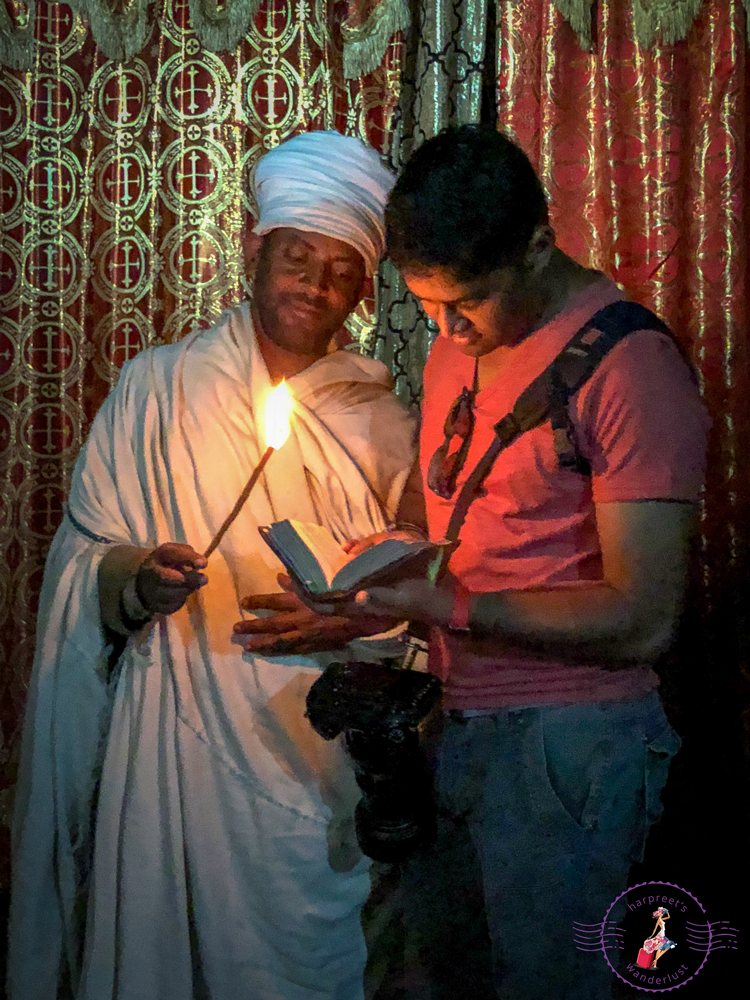
Prayers by candlelight in Yemrehana Cristos
After lunch, head to the ToNeakutoleab Monastery, also set in a cave in the most gorgeous surroundings. The draw here is a sprinkling of water that has no source and so is considered holy and believed to heal. This Monastery also has an Amharic Bible made with parchment, and the priest will be more than happy to adorn his traditional garb and chant some prayers for you for a couple of Birr. Once you are done, head to Lalibela for some shopping and a coffee ceremony with the locals.

The sacred water dripping from the cave at ToNeakutoleab Monastery

Amharic Priest and Ancient Bible at ToNeakutoleab Monastery

Coffee ceremony with the locals in Lalibela
Go for sundowners at the quirky flower shaped restaurant Ben Abeba. Ask to be sat by the bonfire once the sun goes down and enjoy your dinner by firelight, and then head out to Torpedo for a night on the town. This is a local bar which brews Tej: local honey wine. For girls: don’t visit the loo here if you can avoid it…
Day 4 – Heading to the Simien Mountains
Today is a full day of travel as you head to the Simien Mountains. Fly from Lalibela to Gondar, the only town with an airport that is closest to Debark where the Simien Mountain range is located. Debark is 100 km away from Gondar and the drive there is amidst simply stunning landscapes and gorgeous vistas with views to die for. Enjoy the heat of the day as the mountains are super cold! The tarmac road network is great however out in rural Ethiopia, humans and livestock have right of way and this will slow the journey down somewhat. Once in Debark, you must register at the Simien Mountain National Park Office and pick both a guide and a scout. These are allocated at random and are the luck of the draw, and our guide Gismu and scout Abrham turned out to be amazing people.
Fly: 12:20 am Ethiopian Airways from Lalibela to Gondar.
Lunch at Four Sisters in Debark to try amazing Doro Wat.
Check in: I would recommend staying at Simien Lodge as it is the only semi luxurious lodge inside the National Park. There are more luxurious lodges available however these are almost an hour away from the park, and given the time limitations, the closer you are to the park the more time you have to explore.

Epic drive from Simiens to Axum
Entry: 90 Birr per person per day. 300 Birr for a scout and guide for 1-4 people excluding tips.
Day 5 – Exploring the Simiens
I would highly recommend waking up for sunrise over this spectacular chain of mountains. The magic of having the park to yourself and watching the world come alive in the crisp morning breeze is ethereal. Head back to the lodge after sunrise for breakfast and hop into your 4×4 with your guide and scout to explore the rest of the park starting with hanging out with the Gelada Baboons and ending at the highest point: Chenek Camp, set 4300 metres above sea level. Though the most popular way of getting to Chenek is by hiking the Sankabar-Geech- Chenek trail within the park, for those with time constraints it is also possible to drive though you will need a sturdy 4×4 to traverse the bone shaking road.

Sunrise in the Simiens
First up: the Geladas, also known as the bleeding heart baboon because of the distinctive red patch on their chest and only found in the Simiens. They are the last surviving species of grazing monkey in the world and are so docile you can sit amongst them and observe their almost human like behaviour for hours on end.

Wanderlustmate M chilling with the Geladas
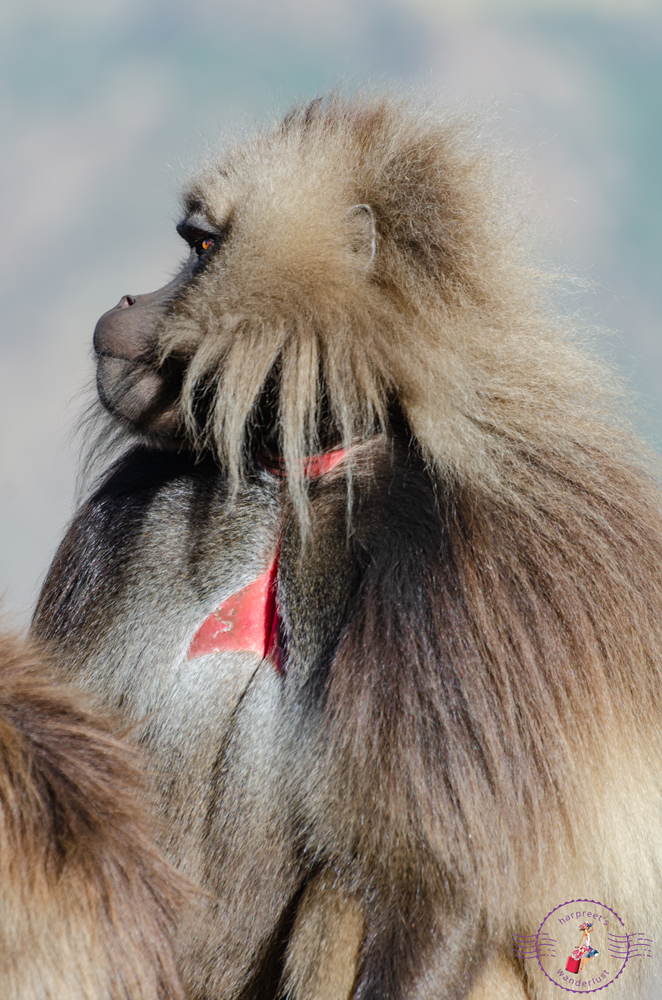
Male Gelada
Next: make your way towards Chenek a 30 km drive up from Simien Lodge. The landscape changes dramatically the higher you climb: the Simiens cliffs rise from bottomless canyons adorned with the occasional firestick making the otherwise dry landscape burst with colour. The road is cut into the mountainside and every turn has you gasping in awe at the dramatic vistas before you. Chenek and beyond is where you will find the elusive Ethiopian wolf, Walia Ibex and giant lobelias: in a terrain so cold that even the streams of water are ice! You can hike short distances here to get a feel of what the trails are like and then break for a picnic lunch at Chenek before making your way back down to Simien Lodge. Your guide can recommend short trails during the day to show you dramatic vistas, such as the short 7 km hike to the Jinbar waterfall. End your day amongst the Geladas near Simien Lodge.
Day 6 – Onward to Axum: ancient capital of Abyssinia and home to the legendary Queen of Sheba
More traversing by road today on the 300 km journey from Debark to Axum. Leaving at the crack of dawn, it takes 45 minutes from Simien Lodge to Debark and then you join the “limalimo” – one of the most scenic but hair raising roads we have ever driven on. Cut into the side of the mountain, the road twists and turns and hairpin bends its way amidst the almost Toblerone shaped hills to Zarima, where the tarmac road begins and you start snaking your way along the mountains towards Axum. You leave the Amhara region behind and enter the Tigray region, the whole journey taking approximately 8 hours with a break for coffee and lunch. After checking in to the only semi luxurious hotel in Axum, head out to explore the sights which include: the Stellae (obelisk) park, Queen of Sheba bath, the Tombs and the Queen of Sheba Palace Ruins.
Check in: Sabean International Hotel – the only semi luxurious hotel in town.
Entry into Axum’s Sights: Stellae Park: 50 Birr per person which includes the park, museum and Queen of Sheba’s Palace ruins.

Stellae in Axum
Day 7 – En route to Tigray
The last two legs of this trip are perhaps the most exciting because of just how remote the sights you will be visiting are. Hawzen, where the Wukro cluster of churches are located is a 190 km drive from Axum. For guys: do not give up the opportunity to visit Debre Damo in Adigrat which is en route to Hawszen, one of the most important monasteries in Ethiopia set on the top of a formidable cliff only accessible by climbing a rope. Sadly, no females are allowed in any shape or form and so Wanderlustmate M made the climb up and described it as exhilarating and unbelievable. Given the distance travelled today, you won’t have time to explore the churches as they close at 5:30 pm.
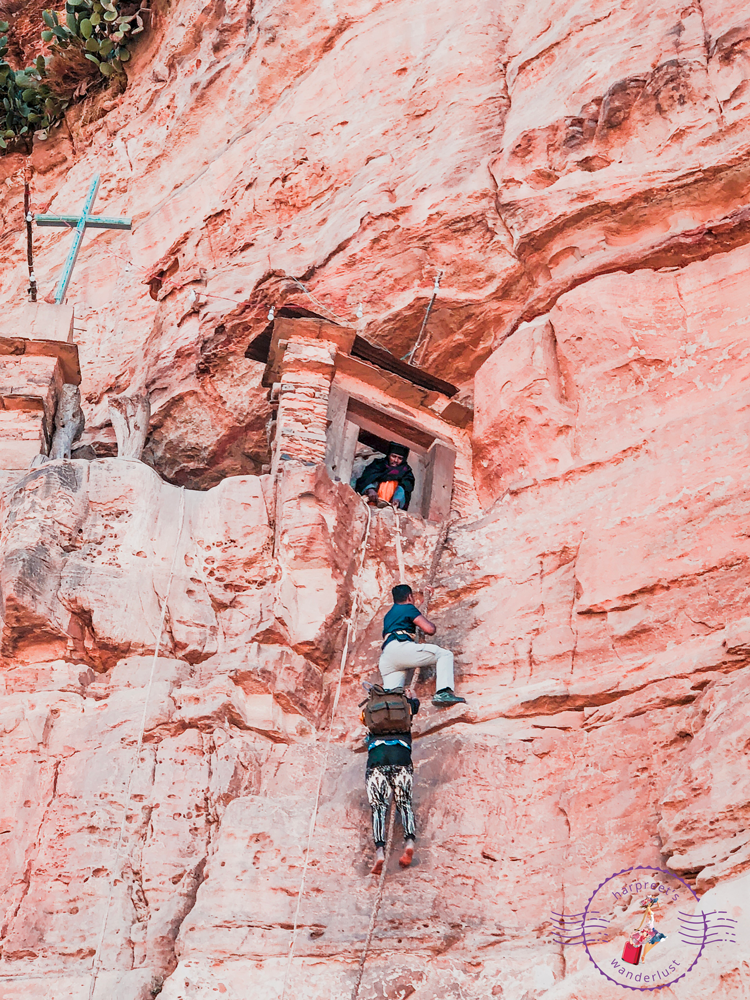
Wanderlustmate M scaling the cliff up to Debre Damo
Check in: Korkor Lodge. By far the most luxurious lodge in Ethiopia however booking is elusive and can only be done through your local agent, and even then, not guaranteed as I will detail in my upcoming Footsteps in Tigray post(s).
Entry into Debre Damo: 200 Birr for men only. You will have to get a guide and possibly a helper who come at 200 Birr and 100 Birr respectively: these are official prices however the helpers will no doubt ask for more as they claim to “save your life” as you make the arduous climb up the cliff.
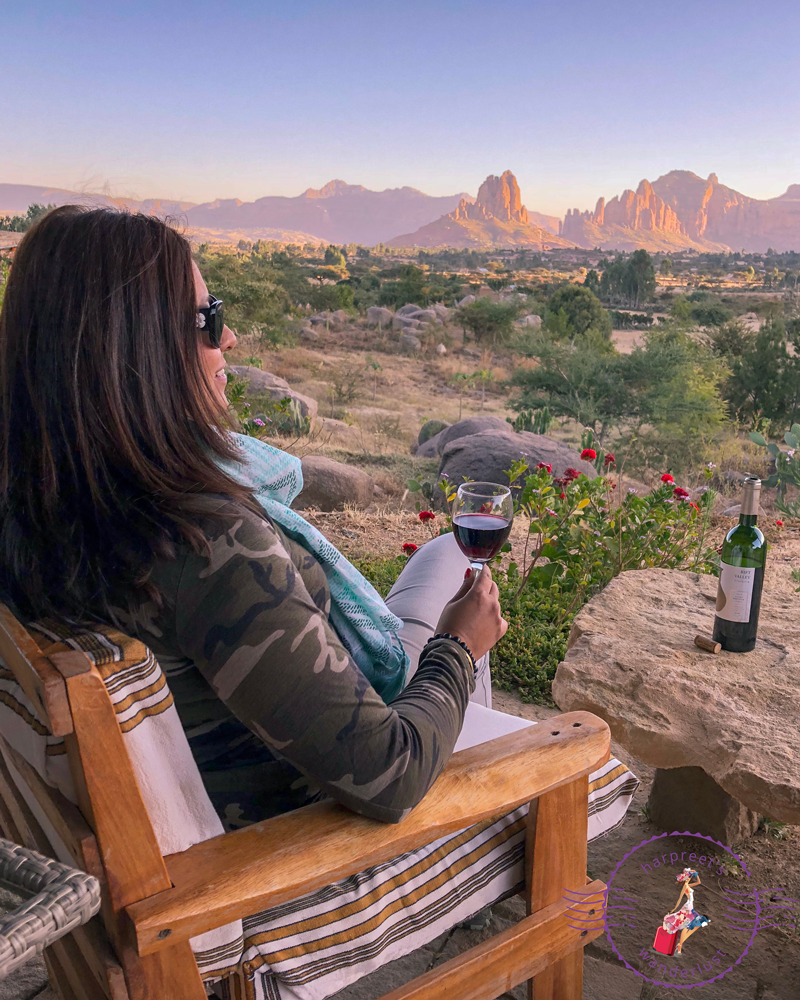
Korkor Lodge – luxury in Tigray
Day 8 – Rock hewn Churches of Tigray
Perhaps the most memorable day of all, today you will hike to impossible to reach churches set high up in the Gheralta mountains. There are a number of Churches out here but the best two are Maryam and Daniel Korkor and Abuna Yemata Guh, where you are guaranteed to find the priests and be able to spend time absorbing the beauty of the Churches. Start off early by first visiting Maryam and Daniel Korkor. This is a 3 hour round trip trek and I will detail my experience in my upcoming posts on my Footsteps in Tigray. The hike is tough, over large boulders for a good 45 minutes before you have to navigate narrow trails and scale almost vertical rock faces. Maryam Korkor is an unassuming white Church, whilst Daniel Korkor, approached via a ledge along a cliff is set inside a cave and has breath takingly gorgeous frescoes within.
Top Tip: get yourself a 4×4 which will take you as close to the base as possible, shaving a good 1km off the trek and saving energy for the gruelling hike up to the churches.

Hiking to Maryam Korkor

Wanderlustmate M on the ledge to Daniel Korkor
After lunch, head to Abuna Yemata Guh: possibly the best Church in the Tigray region for its sheer adrenaline inducing climb and the most stunning frescoes inside this impossible to reach Church which I had to give up getting to halfway because of lack of stamina. Wanderlustmate M made the arduous climb up the sheer vertical rock face along the Gheralta massif and to date, I have wanderlustenvy.

Priest at Abuna Yemata Guh

Amazing frescoes in Abuna Yemata Guh
Practicalities:
You need to be pretty fit to do these hikes: the remote location of these churches require physical stamina to conquer. They are also perched high up in the mountains so you need to appreciate height. Wear sturdy hiking shoes with a good grip as the terrain is tough, though you will climb up to Abuna Yemata Guh barefoot once you get to the vertical wall, for better grip. A hiking pole also helps with balance. Take more water than you think you need, and do get yourself a scout: they are invaluable for helping along the tricky bits. Carry small change for the priests and scouts as they never have change. Let the priests show you around by candlelight: it is absolutely magical.
Entry: 150 Birr per person for the Churches, 50 Birr for the priest (or the man with the key), 100 Birr for the scouts who attach themselves to you to help you climb up and down the tricky bits, and 150 Birr for use of the rope to Abuna Yemata Guh.
Day 9 – The Afar: Simply Epic.
Leave Tigray to head to the Afar region where the Great Rift Valley starts, winding its way from Ethiopia into the rest of East Africa, known as one of the most inhospitable places on earth: Dallol is the 3rd hottest place on earth! The drive today is also about 7 hours, leaving Hawzen to get to Mekelle, and thereafter to the Danakil Depression. Given that the Afar is completely off the beaten path because of how remote the region is coupled with the complete lack of infrastructure, there is NO luxury out here and you have no choice but to book this through one of the experienced local operators, which send large groups out due to cost. The proximity to the Eritrean border means you need military escort which doesn’t come cheap and is one of the reasons for the high cost. I would highly recommend paying extra to have your own air conditioned car for the added comfort, which is what we did however you have to join a group once at camp to partake in the activities. In hindsight, despite my initial trepidation (I am a creature of comfort, unapologetically so) this is one leg I would not leave out for the world, lack of luxury and all. It is the most memorable and made our trip to Ethiopia simply epic. On Day 9, we drove to Mekelle and then onwards to the Danakil Depression and finally to Lake Asale, one of the lowest points on earth in the salt flats that rival those of Salar de Uyuni and the Kalahari. We had sundowners amidst salt caravans and slept under the stars with these caravans traversing silently amongst us all night. Absolutely surreal.

Salt Caravan heading off into the sunset

Salt flats in the Danakil Depression, Afar region
Practicalities:
1. The Danakil Depression is where you will see the start of the Great Rift Valley, Lake Asale, Camel Caravans, the salt miners of the Afar Region and the Sulphur Lakes of Dallol. Do note that if you visit the salt mines on a Friday, you will not get to see the miners at work as the Afari are muslims and Friday is their day off.
2. Given the security situation because of the political tension between Eritrea and Ethiopia, you need military escort to explore this region, which is why you have no choice but to join a group even if you choose to travel in a separate car. This situation may change given the current political climate however when we went we still needed military escort which was organised by our tour operator.
3. As you are in a group, you will be on group schedule and do things according to what the group leader deems appropriate, especially as cars have to be in convoy for security in this region. This means that you will have little to no time for taking photos of these places if you are an avid photographer. If photography is what you are after then perhaps talk to the travel agency to try and organise a tour where you have more time to pursue the shots you are after, at an additional cost no doubt.
Checking in: In the Danakil Depression:
The “accommodation” is rustic. You will be in a campsite with everyone else in the group, and your sleeping quarters consist of a bed in the open next to your car. You sleep under the stars in the open – which works very well because it is really hot and you would suffocate in a tent. There are no bathroom facilities so be prepared to ‘go’ in the bush (if you can find one). I must admit that I was very sceptical of this arrangement at first, given that I hate camping. However in hindsight, I am so glad that I had this experience. There is something unexplainable about being in the middle of the salt pans, with the stars twinkling in the sky, and waking up to camel caravans passing you silently in the night.
Day 10 – From the Danakil Depression to climbing an active volcano: Erta Ale
A sunrise start this morning to explore the almost martian like landscape of Dallol, which is a 20 minute drive away from the campsite. You do have to hike up about 10 minutes or so to get to the colourful sulphur lakes, which bubble and boil away and leave you gaping in awe that such a place exists on earth! You also get to explore the red salt mountains and the yellow pond, not far from each other in this area but if you are heading out to Erta Ale then your time out here will be limited to about an hour and a half in total. This morning also includes seeing the Afari salt miners however we were out of luck as it was a Friday which is their day off.
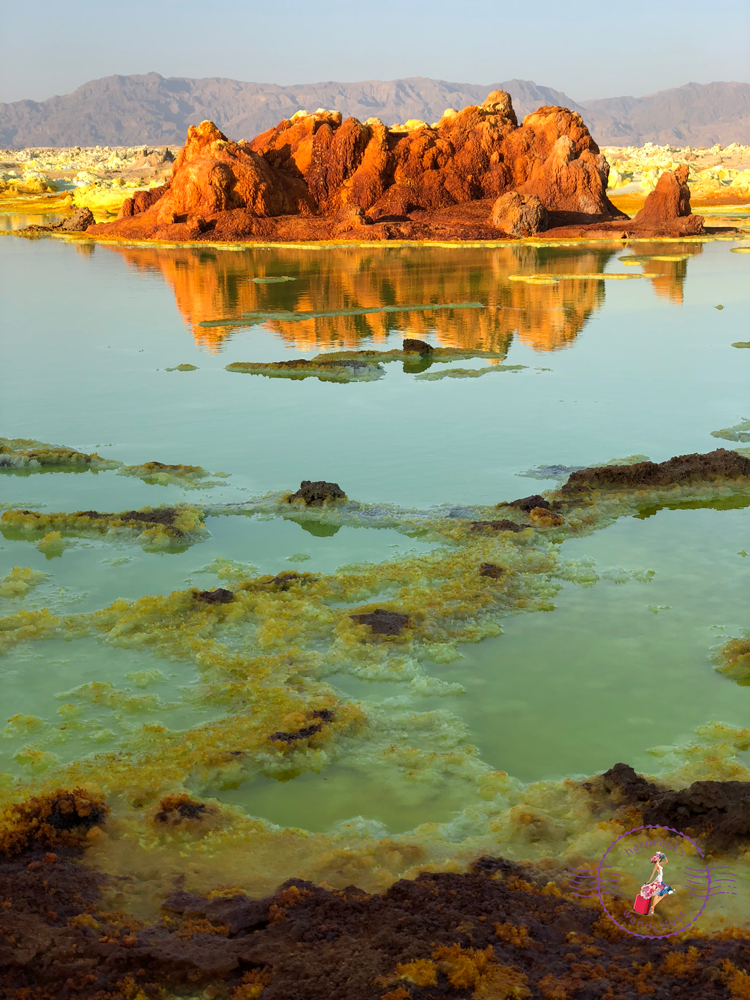
Surreal sulphur lakes of Dallol in the Danakil Depression
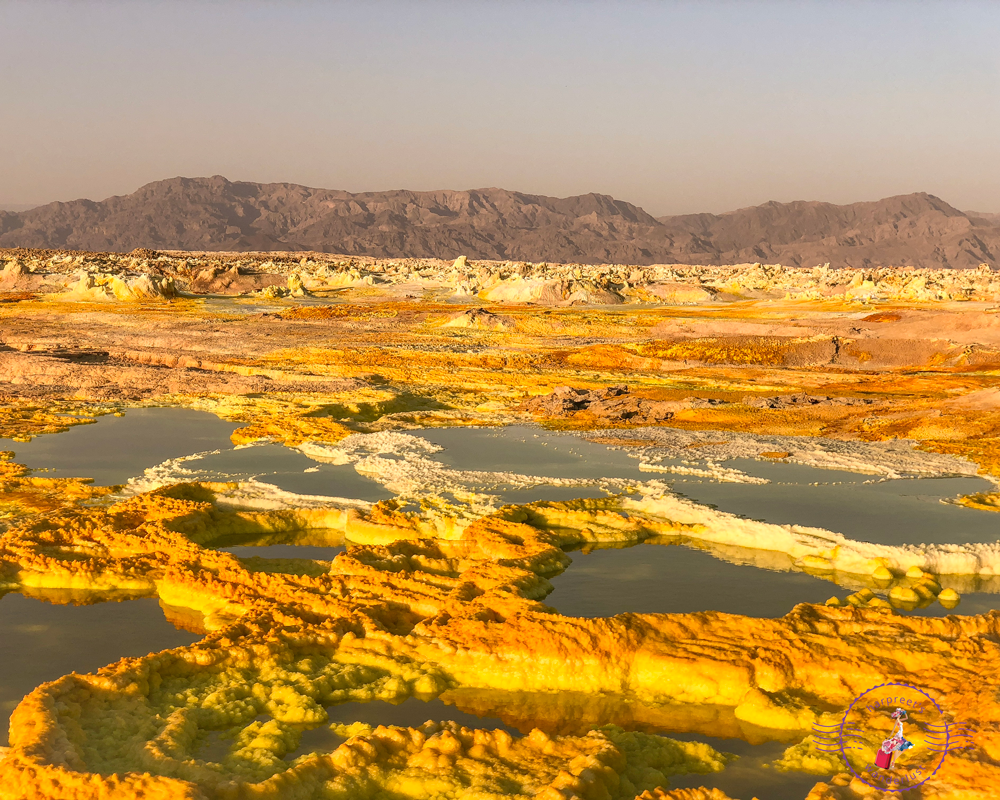
Surreal landscapes – sulphur lakes of Dallol
Erta Ale, the active volcano that you will climb tonight is 380 km away from the Danakil Depression. Once again, as this is a group tour, you are divided into groups of between 10-20 people with a guide. You trek up to the rim of the active volcano at 8 pm after dinner, because this is when it is coolest (weather wise) to do so. Military escort means you get safely up to the top, where you then descend into the actual rim to see the lava lake, depending on the direction of the wind. You spend the night on the rim in sleeping bags brought up by the camels, which is truly a once in a lifetime experience.
Top tip: Do carry energy bars or snacks to fuel you on the way up, and also for the trek back down, because you will eat at 8 pm and use up that energy to climb up, depleting you. The food provided is awful and you will be thankful for the added comfort of some snacks. If you don’t enjoy hiking then take a camel back down: you would probably also enjoy the scenery more. One of the regrets I have is that I was so focused on getting back down and keeping up with the group whilst hobbling along with a twisted ankle that all I remember is focusing on the ground in front of me and trying to make it back down in one piece.

Erta Ale spouting smoke in the distance
Day 11: Erta Ale- Mekelle- Addis
A 4 am start to see the lava lake and sunrise on the volcano, after which you make the 3 hour trek down after sunrise. Back at base camp, you have breakfast and can freshen up before the 8 hour drive to Mekelle for your flight back to Addis and literally, back to the lap of luxury.
Top tip: At the lunch stop back to Mekelle, forgo the sludge the tour agent will serve and ask your driver to order you Afari Tibs. These are the most delectable goat tibs you will ever eat: the taste will linger on your taste buds for years to come!
Fly: 8 pm Ethiopian Airways from Mekelle to Addis.
Check in: The Radisson Blu, Addis

The red glow of the lava lake at the rim of Erta Ale
Has this mini guide made you want to book a trip to explore this epic corner of the globe in the heart of Africa? I certainly hope so! Please do get in touch with me on Footsteps@harpreetswanderlust.com for information on the local Ethiopian tour agent we used and any further details on planning your trip to the Land of Origins. Stay tuned for upcoming posts on each of these places with wanderlust inducing pictures to go along, and as always, thank you for spending a part of your day with me. Until next time, Happy Wanderlusting xoxo
![]()

Wandernuggets











Gosh this has made me want to go to Ethiopia!!
I am soooo glad to hear that B! You really must…it is so epic! Thank you so much for stopping by xoxo
I am in complete awe Harpreet! I have to go. This is an extraordinary place.
Totally Bejal…one of the most special places I have been to!
Beautiful Write Up!!!! On our backlist of places to visit!!!
So glad to hear that Kamal! Thank you! I hope you do go soon!
What a great write up Harpreet!! Love the detail- better than Lonely Planet!!! And really makes this place go even higher onto the bucket list!!
Thank you so much for your kind words Purvi! They have made the time and effort it took to curate this post worth it!
[…] I said in my article Footsteps in Ethiopia…A Travel Guide for an Epic Trip to the Land of Origins (which was shamelessly stolen by not one but two blogs which I would love to name and shame so that […]
YOU KEEP STEALING MY CONTENT!!!!!!!!!
[…] As the world hops on to the Dalgona Coffee craze, I am indulging the memories of how I became a bit of a coffee fiend. I have always loved tea. I still love tea, but I have grown to love coffee more and my love affair with this beverage started when we set footsteps in Ethiopia. […]